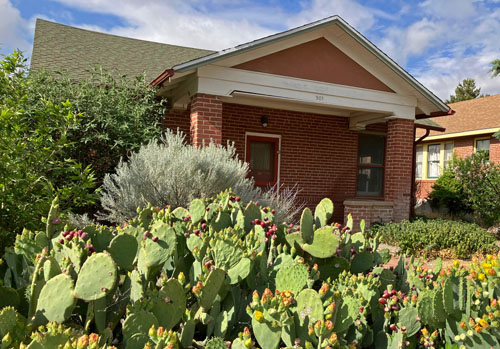By Nancy Gordon ?
Full slideshow below.

You probably drive by it all the time, that little brick house at the corner of Kentucky and 12th Street. You may not know that WNMU owns it. It is a “twin” to the privately-owned house next door, which is listed on the State Register of Cultural Properties and is certified as a Town of Silver City Landmark Structure. They are both equally valuable as historic resources and should be preserved as a set.
WNMU purchased the corner house at 901 West 12th Street in 2016 and did little to maintain it. It has been used for storage of supplies, scarring the oak floors. A slow water leak in one bathroom went unattended. Feral cats moved in. WNMU’s Albuquerque-based architect said it would cost over $1 million to rehabilitate it. Too much. In January, it was slated for demolition.
And then community members got involved. The decision to demolish it was put on hold.
The Town’s Historic Design Review Committee held a meeting in February with WNMU staff and one Regent in attendance. Susan Berry, former Silver City Museum Director, was invited to give a presentation on the house. She talked about its value to the neighborhood and to Silver City’s architectural history, and its association with prominent figures from Silver City’s past. She said:
“A few parking spaces and/or a bit of landscaping do not justify removing one of the neighborhood’s two most important historic structures and endangering the other. For over a century these well-built bungalows have anchored the back entrance to the campus on Twelfth Street. They reflect the hopes and ideals of an earlier Silver City, and they do so with style.”
Then in March, WNMU President Shepard held a community meeting, with Dr. Jeff Pappas of the State’s Historic Preservation Division (HPD) attending by Zoom. Pappas explained that WNMU must consider alternatives to demolition because of the potential impact on the registered house next door.
They’re still considering.
In the meantime, a few of us delved into 901’s storied past to provide documentation for adding it to the State Register of Cultural Properties. WNMU would have to submit the proposal, and is not interested in doing that at this time, but may be in the future. Listing the house would help protect it from demolition, and would mean consulting with HPD on any planned modifications, to ensure its historical integrity. Listing would also open up additional funding opportunities for rehabilitation.
The two houses at 901 and 905 West 12th Street were built in 1918 for Bessie Harper, one of Silver City’s infamous madams, as income rentals. If you attended the Memory Lane Live! event in May, you might have seen Bessie Harper (portrayed by Liz Mikols) standing at a headstone dated 1855-1929, and learned how Bessie was quite a firebrand in her younger days but was later known for her many charitable acts.
Bessie Harper was born in Indiana and may have made her way westward with a traveling variety show troupe. Her name appears in an 1883 playbill for a performance at the Bird Cage Opera House in Tombstone, Arizona. She may have already been engaging in her more lucrative form of employment before she came to Silver City later in the 1880s. She and another madam, Kate Stewart, initially set up shop on south Texas Street. After the Big Ditch split the town in two, they moved their places of business over to the 500/600 blocks of Hudson Street. This red-light district would eventually be acquired by Mildred Clark Cusey (the legendary Madam Millie), who would continue operating until 1969. Silver City’s original 1878 charter contained language prohibiting “bawdy and disorderly houses,” but this regulation was loosely enforced.
Bessie must have prospered from her line of work, as she acquired a considerable amount of property during her time in Silver City, including two mines and several rental houses. At the time her twin brick bungalows on 12th Street were built, they were the finest and most substantial houses in that part of town. Bessie may have strategically located them adjacent to the 20-acre parcel originally allotted to the New Mexico Normal School (now WNMU) with the idea of renting to faculty or students.
Just before she passed away, Bessie sold her twin houses to Jack Borenstein, a successful businessman and community leader. Jack’s father and uncle had immigrated to the United States in 1890 from the Ukraine in Russia. They worked their way across the country, peddling pots and pans from a covered wagon. After settling in Silver City and establishing a successful retail business, they brought their families to America to join them -- including Jack, who was then five years old. Coincidentally, Jack’s family may have rented one of Bessie Harper’s houses on Hudson Street before she took up occupancy there.
Jack’s father and uncle grew their business, which would eventually become a high-end department store. They frequently traveled to New York to bring back the latest fashions. The store which would become Borenstein’s went through several name-changes and remodelings. It acquired its current pink terrazzo-tiled, glass-fronted facade in 1950. The store was located at 109 North Bullard next to City Hall, now home to Dandelion Wish and Otter Chaos.
Jack, who with his sister Rosa took over the store after their father died, was also founder and president of the Masonic Lodge and president of the Elks Club, as well as serving on the Town Council and with the Chamber of Commerce. He and his business partner Josh Brent saw the need for a movie theater in town and in 1949 spent over $100,000 to build the Gila Theater. Jack’s sons later donated the theater to the Town of Silver City for use as a performing arts theater, but it is now privately owned.
Jack Borenstein and his wife Marjorie lived in the house at 901 West 12th Street now owned by WNMU, and rented out the adjacent twin house. Their two sons, David and Daniel, grew up in the house at 901. I had the pleasure of corresponding with Daniel, who had a distinguished career as a psychiatrist in Los Angeles. He provided a substantial amount of historical information for a potential State Register listing. In an email, Dr. Borenstein said: “It would be great to preserve the property. I attended NM State Teacher’s Grade School, a short walk from the house. It would be sad for its related educational institution to demolish it.”
At the time WNMU purchased the house at 901 West 12th, the three-bedroom, 2-bath brick bungalow was appraised at $159,000 and was rated as being “well maintained.” The appraisal stated that its highest and best use was “single-family residential.” It was WNMU’s original intent to continue to rent it to the current occupants. However, this did not occur and the house has remained vacant. WNMU subsequently considered using it as a mathematics study lab or office space and upgraded the electrical service to make it code-compliant. However, they abandoned these plans after a 2020 study by their architect noted a number of deficiencies and recommended repair or replacement of basically everything except the brick walls – the roof, floor, windows, doors, heating/cooling systems, plumbing, lighting, and communication systems – leading to the $1 million estimate for rehabilitation.
The state’s Historic Preservation Division maintains a list of qualified architectural consultants, and WNMU’s architect is not on that list. A contractor or architect with expertise in working with older dwellings may be able to come up with a more cost-effective alternative for renovation -- one that provides for structural stability but allows some deviation from plumb and square. Historic preservation expertise is also needed to ensure that compatible materials are used, e.g. lime-based plaster and mortar. Re-using old buildings is considered “green architecture” (as opposed to using new materials), which would fit with WNMU’s carbon-neutral initiative.
With the current housing shortage in Silver City, it seems like a waste to let this house sit idle. It will undoubtedly need repairs, especially to the roof. However, a private owner might be more tolerant of the quirks of older houses like cracks in the walls, a floor that isn’t level, and a boiler/radiator heating system, and would likely be able to make the house livable for less than $1 million. However, WNMU is not interested in selling it at this time. In fact, WNMU was hoping to also acquire the twin house next door when it came up for sale this year but it went to a private party.
The future of the house at 901 West 12th Street remains uncertain. And so it sits, awaiting its fate.
You might be interested in knowing that WNMU considers any property within the 12th-West-College-E-8th Street boundaries to be “within a consistent campus perimeter” and desirable for acquisition. Several houses in that zone are shown in the book Built to Last by Berry and Russell as historic structures. Anyone in that zone who owns a historic house might want to consider listing it on the State Register to provide it and its neighbors a layer of protection. Information on listing can be found at: www.nmhistoricpreservation.org/programs/registers.html .
This article is a condensed version of the narrative that was prepared for listing the house at 901 West 12th Street on the State Register of Cultural Properties. Susan Berry, Dr. Daniel Borenstein and several others were of immense help in developing that narrative. If you would like to follow future developments, please contact the author at:
To pause the slide show, mouse over the image.










